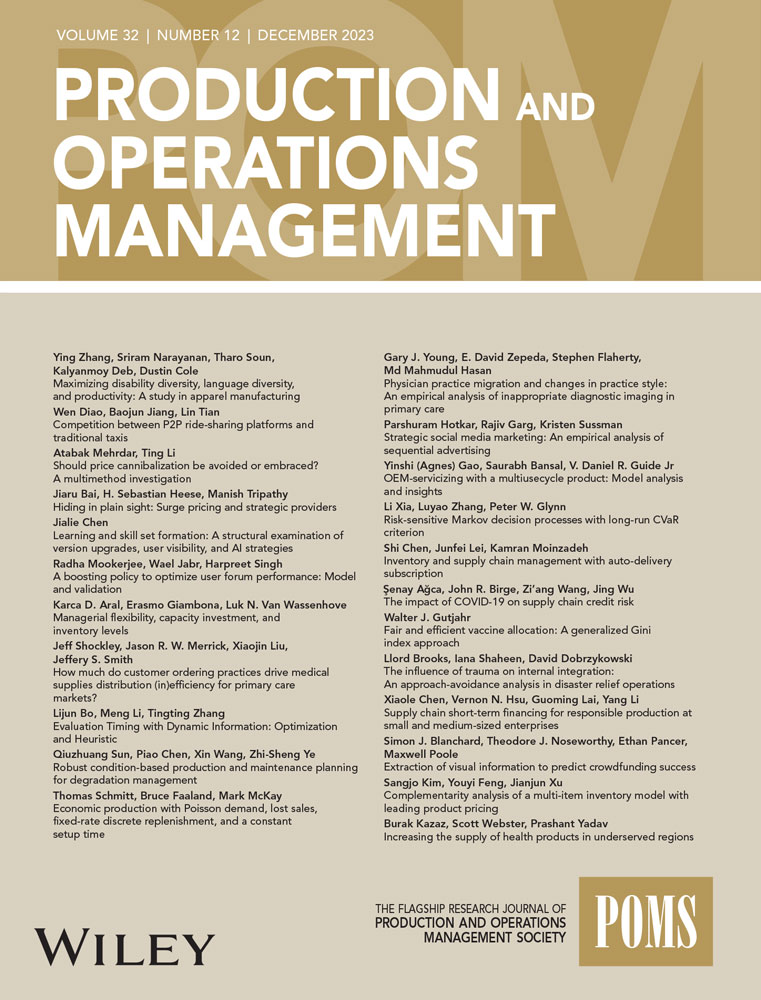Group Buying Between Competitors: Exogenous and Endogenous Power Structures
IF 4.8
3区 管理学
Q1 ENGINEERING, MANUFACTURING
引用次数: 0
Abstract
Competing firms may engage in group buying (GB) to benefit from a quantity discount from a common supplier. We study GB under different power structures (i.e., Nash and Stackelberg) and investigate how the power structures can be endogenized along with the resulting GB outcome. We employ a game-theoretic framework in which two firms under Cournot competition can group their purchases if it is beneficial compared to individual purchasing. We show that under exogenous power structures, when the two firms have highly asymmetric market bases, Nash GB is unattainable due to severe co-opetition conflict, and Stackelberg GB can better resolve the conflict. Our results suggest that power structures may fundamentally affect firms’ GB incentives, and no power structure is always superior to others. We then endogenize the power structures of the two firms based on a two-stage extended game. Using Pareto-risk dominance, we identify conditions under which one firm endogenously emerges as the Stackelberg leader with the rival as the follower, as well as the conditions under which both firms endogenously choose Nash GB or opt for independent purchasing. We demonstrate that the two firms can largely resolve the battle for GB leadership and achieve an efficient outcome in most cases. Our study is the first to compare different exogenous power structures and consider endogenous power structures in the context of GB.竞争对手之间的团购:外生和内生权力结构
相互竞争的企业可能会参与团购(GB),以从共同供应商的数量折扣中获益。我们研究了不同权力结构(即纳什和斯塔克尔伯格)下的团购,并探讨了权力结构如何与团购结果一起内生。我们采用了一个博弈论框架,在这个框架中,处于库诺竞争下的两家公司可以进行集团采购,如果这比单独采购有利的话。我们的研究表明,在外生性权力结构下,当两家公司的市场基础高度不对称时,纳什国标会因严重的合作竞争冲突而无法实现,而斯塔克尔伯格国标则能更好地化解冲突。我们的研究结果表明,权力结构会从根本上影响企业的国标激励,没有哪种权力结构总是优于其他权力结构。然后,我们在两阶段扩展博弈的基础上内生了两家公司的权力结构。利用帕累托风险优势,我们确定了其中一家公司内生成为斯塔克尔伯格领导者而对手成为追随者的条件,以及两家公司内生选择纳什国标或选择独立采购的条件。我们证明,在大多数情况下,两家公司可以在很大程度上解决国标领导者之争,并取得有效的结果。我们的研究首次比较了不同的外生权力结构,并考虑了国标背景下的内生权力结构。
本文章由计算机程序翻译,如有差异,请以英文原文为准。
求助全文
约1分钟内获得全文
求助全文
来源期刊

Production and Operations Management
管理科学-工程:制造
CiteScore
7.50
自引率
16.00%
发文量
278
审稿时长
24 months
期刊介绍:
The mission of Production and Operations Management is to serve as the flagship research journal in operations management in manufacturing and services. The journal publishes scientific research into the problems, interest, and concerns of managers who manage product and process design, operations, and supply chains. It covers all topics in product and process design, operations, and supply chain management and welcomes papers using any research paradigm.
 求助内容:
求助内容: 应助结果提醒方式:
应助结果提醒方式:


